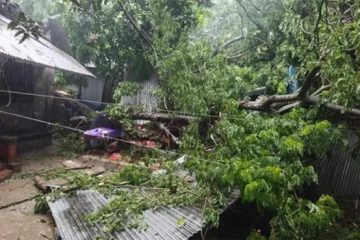Shahidul Islam Chowdhury
Severe air pollution is choking the citizens in the Dhaka and Chittagong cities with poisonous particles in the air exceeding the permissible level of human toleration. The citizens are at a serious health risk due to the highly-polluted air.
‘Many patients, both elderly and young, are coming to us these days with serious respiratory and pulmonary problems,’ Dr Ali Hossain of National Institute of Diseases of the Chest and Hospital told New Age.
‘Breathing polluted air is a major cause for the increase in the number of patients suffering from lung inflammatory reactions, bronchitis, respiratory troubles and adverse effects on the cardiovascular system,’ he said, citing a study conducted by the hospital.
He said short-term health hazards like respiratory problem, cough and headache can occur within a few hours or days after breathing polluted air. ‘It may even lead to cancer,’ Dr Hossain warned.
People in general and children in particular are more susceptible to acute air pollution in places like Tejgaon and Old Town because of severe traffic congestions, noise from construction works and industrial emission, he said.
SM Imamul Huq of the department of soil, water and environmental science of Dhaka University said air pollution has long-term effects on human health if they remain exposed to polluted air for long.
‘Air pollution also damages living environment including plants and animals,’ he said, adding, ‘It also reduces agricultural productivity by limiting the process of photosynthesis.’
Faulty vehicles with old engines, diesel-run human haulers, buses, trucks, covered vans, tempos, uncontrolled traffic congestion, brick kilns, industrial emission and unprotected construction works are among the main sources of air pollution, Mohammad Nasiruddin, project director of the Air Quality Monitoring Project under the Department of Environment, told New Age.
The number one cause for air pollution in Dhaka city is traffic congestion and faulty vehicles add to it, he said.
‘PM10, mostly emitted by vehicles, brick kilns and industries, is the dominating poison in the air in and around Dhaka city, containing on an average 340 to 345 micrograms of the deadly particulate, including poisonous carbon monoxide, sulphur dioxide and nitrogen dioxide,’ he said.
‘PM10 is more than double on the permissible level in Dhaka. The permissible limit for PM10 is 150 micrograms.’
He said the amount of PM2.5, which is equally dangerous, is 180 micrograms in each cubic metre in the capital, a city of more than 120 million people. ‘It is about three times above the permissible limit of 65 micrograms’, Nasiruddin said.
According to experts, due to increased PM10 and PM2.5, people lose lung function and suffer from chronic respiratory and cardiovascular diseases. Carbon monoxide reduces delivery of oxygen into the human body, creates severe headache and decreases visual capability and manual dexterity, while nitrogen dioxide increase risks of bronchitis, pneumonia and respiratory infections.
Nasiruddin said there are about 1,000 brick kilns around the Dhaka city, 500 around the Chittagong city and 5000 across the country. ‘Almost all the kilns use low-quality coal, wood and use tyres, emitting poisonous particles, including sulphur, into the air.’
He said the country needs to revise its emission standard. ‘Emission standard here is 1000 PPM, but in India it is 300 PPM,’ he added.
He said the government is considering initiating Clean Air and Sustainable Development Project which would help cut emission.
According to the AQMP survey, faulty vehicles are the main source of air pollution, as diesel-run vehicles, mainly buses and trucks, alone contribute to 60 per cent of poisonous particles beyond the permissible limit in the air.
About 70 per cent of the motorised vehicles, which have fitness certificates, are polluting the air because of their faulty engines, AQMP sources said.
According to Bangladesh Road Transport Authority, new motorised vehicles were increasing at a rate of about 10 per cent every year across the country. A total of 1,21,272 mechanised vehicles were registered across the country in 2007, raising the total number of vehicles to 1,054,057. Of them, 5,25,751 were covered van, 2,15,456 motor car, jeep and microbus and 34,645 buses.
A total of 36,942 vehicles were registered in Dhaka in 2007, pushing up the total number of vehicles to 4,12,540. Of them, 1,73,637 were motor cycle, 1,62,608 motor car, jeep and microbus, 25,193 trucks and 6,152 buses.
The BRTA director, Rafiqul Islam, claimed that they have started taking measures against issuing fitness certificate to faulty vehicles.
Courtesy of www.newagebd.com




















